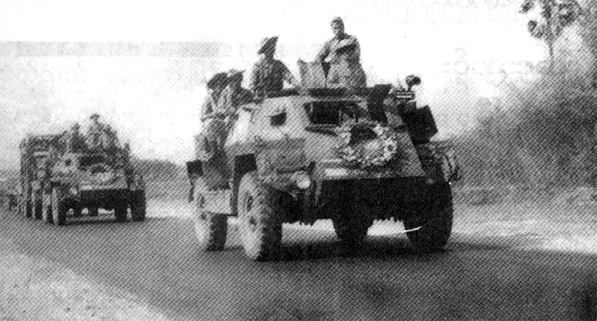The Battle of Insein Never Really Ended

The Battle of Insein began, with the War Office issuing the order: “Not to retreat one inch from your position.”
All roads into Rangoon were blocked by Karen soldiers and only the air route was open for government reinforcements.
The Karen rebels had earlier raided Mingaladon Air Force base and seized ammunition, although they did not take over the airport. If Karen forces had taken the airport, government reinforcements from Arakan would not have been able to land in Rangoon. They would have taken weeks to arrive by sea, and by then Rangoon would have been under Karen control.
In their books, Tun Tin, Kyaw Zaw and Saw Myint maintained that if Rangoon had been taken by the rebels Burma would again fall prey to imperialist slavery under colonialist rule.
Kyaw Zaw and Tun Tin believed that Britain bore part of the blame for the fighting between Karen and Burman. The irony was that Tun Tin and his officers later traveled to London and studied there, learning the “four cuts” British warfare strategy which would later defeat Burma’s ethnic insurgents.
The Battle of Insein failed to have a serious effect on daily life in Rangoon. The city’s cinemas were still showing up to four programs a day and schools remained open.
Movie stars and musicians performed for the troops on the Insein front line, where soldiers requested encores with the plea: “Before we die in the battle, could you please sing one more song!”
Karen snipers commanding strategic positions gave government forces a hard time. Tun Tin recalled telling his men in the face of a fierce Karan attack: “We will never surrender, we will leave our bones here but we will never surrender.”
As Karen soldiers advanced and snipers took their toll, Tun Tin whipped up the morale of his men by climbing from the trenches and urging them on.
Ne Win, an army commander at the time, recalled in the book “Burma and General Ne Win,” written by the scholar Dr Maung Maung, who was briefly president in 1988:
“Once, a troop of men in front of Insein would not move on order to attack. They had grown weary and battle-shy. Tun Tin, their leader, jumped up from the trench and walked up and down with a little swagger telling the men that death would not come until one’s time is up.” Bullets whizzed round like him bees, but he remained untouched. The men then rose and marched forward to attack with Tun Tin leading them.”
Tun Tin was decorated and received the title of “Thura” for his bravery. Others who were awarded medals included Aung San Thuriya and Thiha Thuriya.
Kyaw Zaw, who had previously known only guerrilla warfare, described the Battle of Insein as his “first military academy.” He lost many officers and men in the battle, describing Insein as a graveyard littered with corpses. On the battlefield, he met Col Kyi Maung, who later became a prominent leader of Aung San Suu Kyi’s National League for Democracy.
Ceasefire talks between Karen leader Saw Ba U Gyi and Burmese commanders were mediated by Indian diplomats, but the truce broke down after three days. It was a surrealistic break in the fighting—Karen soldiers were even allowed into Rangoon to watch movies.
The government used the pause to bring reinforcements from upper Burma aboard Garuda aircraft. The Karen found themselves short of ammunition and with no open lines for supplies or reinforcements. The fighting resumed.
During breaks in the fighting, Tun Tin and his officers roamed Rangoon and spent time in a hotel in Fraser Street, now renamed Anawrahta Street. The former colonial-era student prayed at Shwedagon Pagoda for victory, pledging to save the union from disintegration and his motherland’s “fragile independence.”
Although some foreign historians have depicted the Battle of Insein as a conflict between Burman troops and Karen rebels, Tun Tin noted that soldiers from different regions of Burma helped to defend Rangoon.
They included Chin, Kayah, Shan, Gurkha and Kachin battalions (though some Kachin took up arms against the U Nu government).
The most decisive role in defending Insein was played by the 1st, 2nd and 3rd Chin Rifles, fighting on what is regarded as the most strategic battle front of all. Some insurgents, including communists, reinforced Burmese forces before going back to the jungle to repel Burmese troops.
The battle lasted 112 days, finally ending in May 1949. About 500 Karen soldiers and civilians died.
Fifteen major actions were fought before the Karen began to withdraw from Insein at the end of April.
Tun Tin observed the retreat through his binoculars and noted it was calm and impressive. He had to wait before fulfilling that ambition to go shopping in Insein, however.
In a visit to Insein hospital, he saw Karen nurses led by Dr Saw Marcus Paw treating wounded Karen soldiers, singing as they worked.
An Arakanese medic with the Burmese Army, Dr Htun Aung Kyaw, offered to help the Karen medical team.
« previous 1 | 2 | 3 next page »
|
||
|
||
|
||
|
||
|
||
|
||
|
||
|
||
|
||
|
||
|
||
|
||
|
||
|
||
|
||
|
||
- 'My Wife Died From Police Abuse,' Says Husband
- US Says Observer Conditions Don't Meet Int'l Standards
- 159 Observers to Monitor Burma Election
- Govt to Address Breaches of SSA-South Ceasefire: Aung Min
- Burma Investors Pin Hopes on Seminal Sunday
- Malaysia PM Leads 50-Strong Delegation to Burma
- US Congress to Assess Burma's Political Prisoner Issue
- Rangoon Woman in Police Station Death Plunge
- Burmese Legal System Remains Tool of Govt: AHRC
- Burmese Army Chief Defends Political Role
